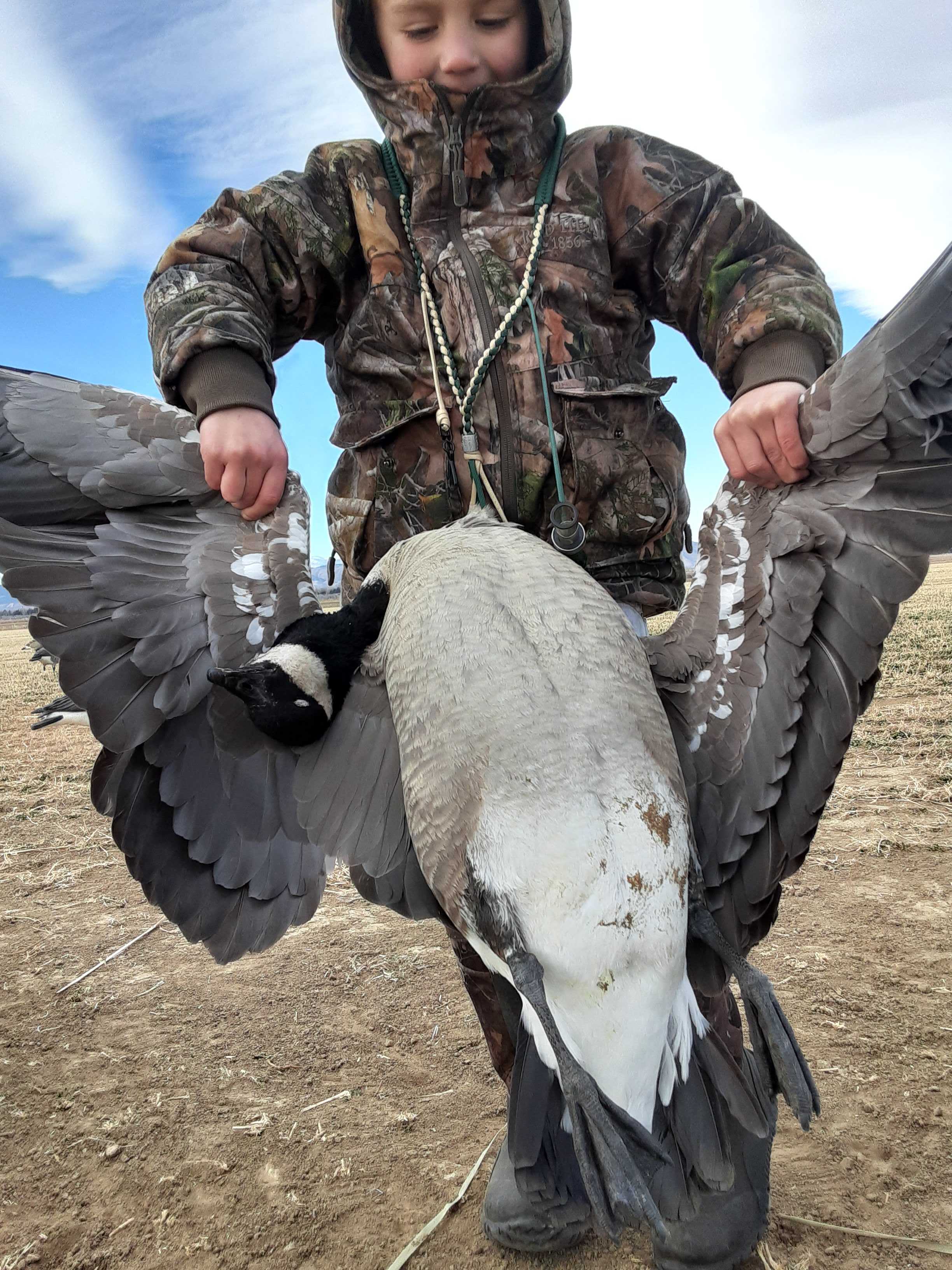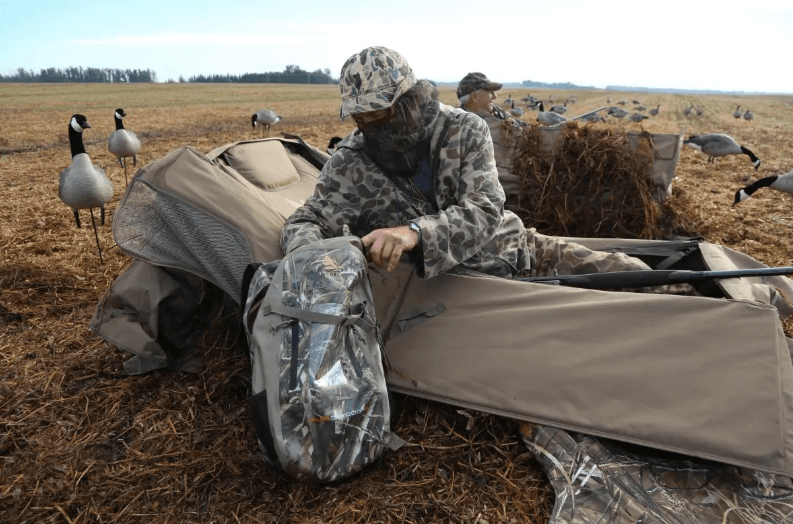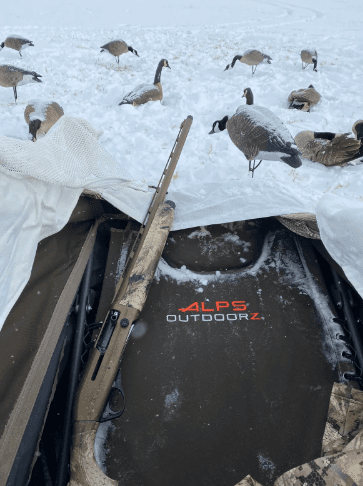Hunting Waterfowl from a Layout Blind: Concealment for Canada Geese, Puddle Ducks, and Snow Geese


Justin Hunold
08/16/2024
Hunting Waterfowl from a Layout Blind: Concealment for Canada Geese, Puddle Ducks, and Snow Geese
When the air turns crisp and the first frost kisses the land, waterfowl hunters know it's time to dust off the gear and prepare for another season. Among the many tools in Waterfowler's arsenal, the layout blind is a true game-changer that promises concealment, comfort, and versatility. Whether chasing Canada Geese over frozen fields, puddle ducks on a late-season pond, or the elusive snow geese across expansive flats, mastering a layout blind can elevate your hunting game to new heights.
Understanding the Terrain and Seasons
Waterfowl are creatures of habit, but their habits change with the seasons and the terrain they find themselves in. To hunt them effectively from a layout blind, you must first understand where and when to set up.
Canada Geese: Fields and Grain Stubble
In the early season, Canada Geese are often found in harvested grain fields, where they feast on leftover kernels of corn, wheat, and soybeans. These fields offer excellent opportunities for layout blinds, as the stubble provides natural cover. Position your layout blind within the feeding area, ensuring it blends seamlessly with the surrounding vegetation.
As the season progresses and temperatures drop, Canada Geese may shift to more secluded areas like frozen ponds or snow-covered fields. In these conditions, it's crucial to match your blind to the environment. Use snow covers for your blinds or pack snow around them to avoid the sharp contrast that can spook wary geese. Set up your decoy spread in a U or J shape, leaving an open landing zone in front of your blind.
Puddle Ducks: Marshes and Shallow Ponds
Puddle ducks are often found in shallow water, where they dabble for food. Early in the season, focus on marshes and small ponds, where abundant vegetation remains. Your layout blind should be placed along the water's edge, with plenty of natural cover to break up its outline. Use natural materials like cattails or reeds to blend the blind into the environment further.
As the season advances and the water begins to freeze, puddle ducks may congregate in smaller pockets of open water. In these conditions, set up your layout blind on the ice near these open areas, using decoys to create the illusion of a larger group of birds. A tight, realistic decoy spread with a few motion decoys can be highly effective in these late-season setups.
Snow Geese: Open Flats and Agricultural Fields
Snow geese are notorious for being wary, and hunting them requires a strategic approach. These birds often favor large, open fields or flats, where they can see predators from a distance. In these wide-open spaces, your layout blind needs to be as inconspicuous as possible. Set up in areas where the birds are naturally feeding or resting, and use decoys to create a massive spread—hundreds of decoys, if possible.
Snow geese are drawn to large groups, so your decoy spread should mimic this. Use a mix of feeders, sentries, and resting decoys to create a lifelike scene. Position your layout blind at the edge of the spread or within a gap in the decoys, ensuring it blends with the surrounding terrain. In high wind or stormy conditions, snow geese may decoy more readily, so adjust your setup to take advantage of these moments.

Best Practices for Layout Blind Setups
The key to effective layout blind hunting is blending in. A poorly concealed blind will ruin even the most well-planned hunt. Here are some best practices to ensure your blind becomes part of the landscape:
- Natural Camouflage: Use the natural vegetation around you to cover your blind. Whether it's stubble, grass, reeds, or snow, incorporating these elements will help your blind disappear.
- Low Profile: Keep your blind profile as low as possible. Avoid creating unnatural mounds or shapes that could alert birds.
- Decoy Placement: The placement of your decoys is critical. For geese, create landing zones within your spread where birds can comfortably land in front of your blind. A smaller, more realistic spread works best for ducks, especially in tighter spaces.
- Wind Direction: Always consider wind direction when setting up. Waterfowl typically land into the wind, so position your blind accordingly, with decoys leading them to your kill zone.
- Weather Considerations: In snowy or rainy conditions, use waterproof covers on your blind and decoys. Adjust your setup to account for visibility—birds will often fly lower in these conditions, making concealment even more critical.
What to Bring in the Layout Blind
Preparation is key when hunting from a layout blind. Here's a list of essential items to bring along to ensure a successful and comfortable hunt:
- Comfortable Seat or Cushion: Since you’ll be spending a lot of time in the blind, a comfortable seat or cushion can make a significant difference.
- Warm Clothing: Layering is crucial for maintaining warmth in cold conditions. Bring extra gloves and a hat to stay warm.
- Calls and Lanyards: Depending on your target species, bring appropriate calls to entice birds into range.
- Ammunition: Ensure you have enough shells for the hunt stored in a dry, easily accessible place.
- Decoy Bag: A bag to store and transport your decoys is essential. Choose one that’s durable and easy to carry.
- Snacks and Water: Long hours in the blind require sustenance. Bring enough food and water to keep your energy levels up.
- Blind Bag: A small bag to store miscellaneous items like a headlamp, extra batteries, or hand warmers.
- Knife or Multi-tool: Handy for various tasks, from cutting brush to adjusting decoys.
- Camo Face Paint or Mask: To further conceal any exposed skin.
- Dog (Optional): If you have a retriever, bring along your dog to help recover downed birds.

Pros and Cons of Hunting from a Layout Blind
While layout blinds offer numerous advantages, they have their drawbacks. Here’s a breakdown of the pros and cons:
Pros:
- Concealment: Layout blinds are excellent for blending into various terrains, offering unmatched concealment.
- Mobility: They are relatively easy to set up and move, allowing hunters to adapt to changing conditions or bird patterns.
- Comfort: Compared to other forms of concealment, layout blinds can be more comfortable, especially when equipped with a padded seat.
- Versatility: Suitable for various waterfowl species and adaptable to different environments.
Cons:
- Limited Visibility: While inside the blind, visibility can be restricted, making it harder to spot incoming birds until they are very close.
- Setup Time: Properly camouflaging a layout blind can be time-consuming, especially in challenging environments.
- Space Constraints: Storage space inside the blind is limited, so you need to be selective about what you bring.
- Heat Management: Layout blinds can become hot and uncomfortable in warm weather.
Different Decoy Spreads for Integrating Layout Blinds
The strategic placement of decoys can greatly enhance the effectiveness of your layout blind setup. Here are some decoy spreads, with diagrams to help visualize each setup.
1. The U-Shape Spread (Ideal for Canada Geese)
This spread creates a natural landing zone within the curve of the U, drawing birds directly in front of the layout blind. Place the layout blind at the bottom of the U, with decoys extending out to the sides. This setup works well when birds are flying directly into the wind.
2. The J-Hook Spread (Versatile for Ducks and Geese)
In the J-Hook spread, decoys are arranged in a J pattern, with the blind placed near the curve of the J. This setup effectively guides birds into the spread's open area, providing clear shooting opportunities as they approach the blind.
3. The X-Pattern Spread (Effective for Snow Geese)
The X-pattern spread is designed to maximize coverage in large fields. Place your layout blind at the intersection of the X, with decoys spreading out in all directions. This setup works well for snow geese, which tend to land in large groups and can approach from any direction.

Conclusion
Hunting waterfowl from a layout blind is an art form that requires a keen understanding of the birds, the terrain, and the seasons. Whether you're after the thunderous honk of a Canada Goose, the splashy arrival of a puddle duck, or the cacophony of a snow goose flock, your success hinges on blending into the landscape and creating a convincing setup. Embrace the challenge, refine your skills, and let the layout blind become your secret weapon in the timeless pursuit of waterfowl.